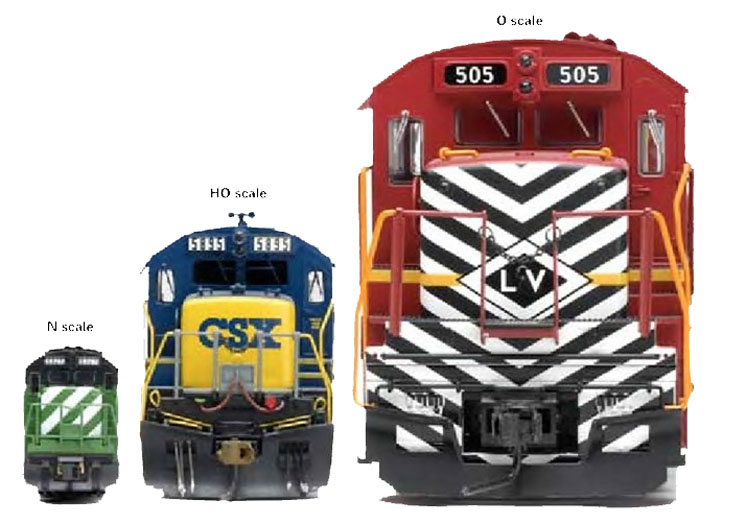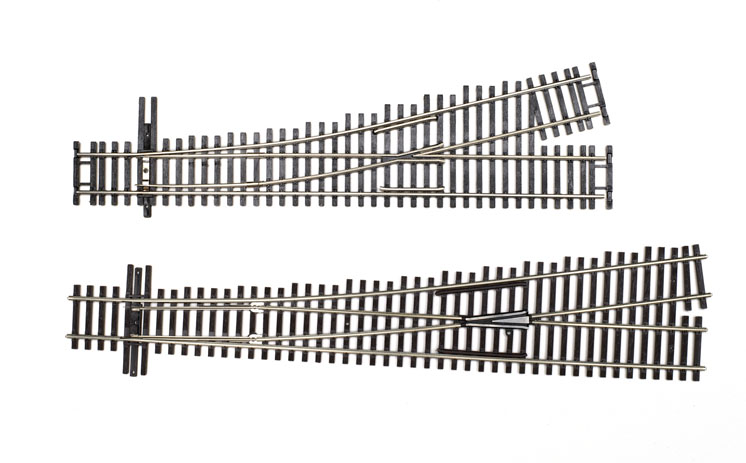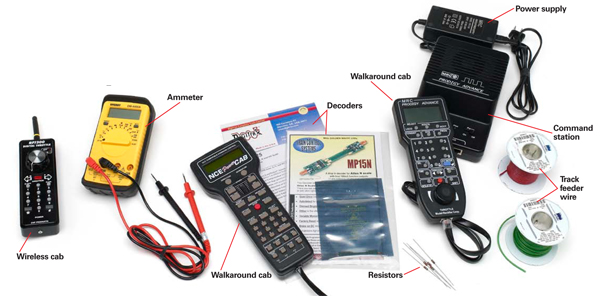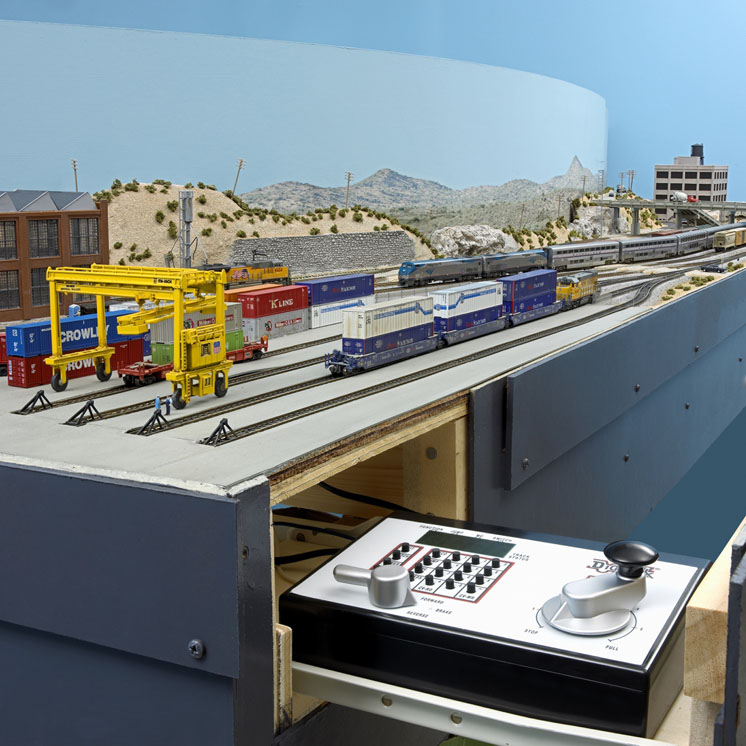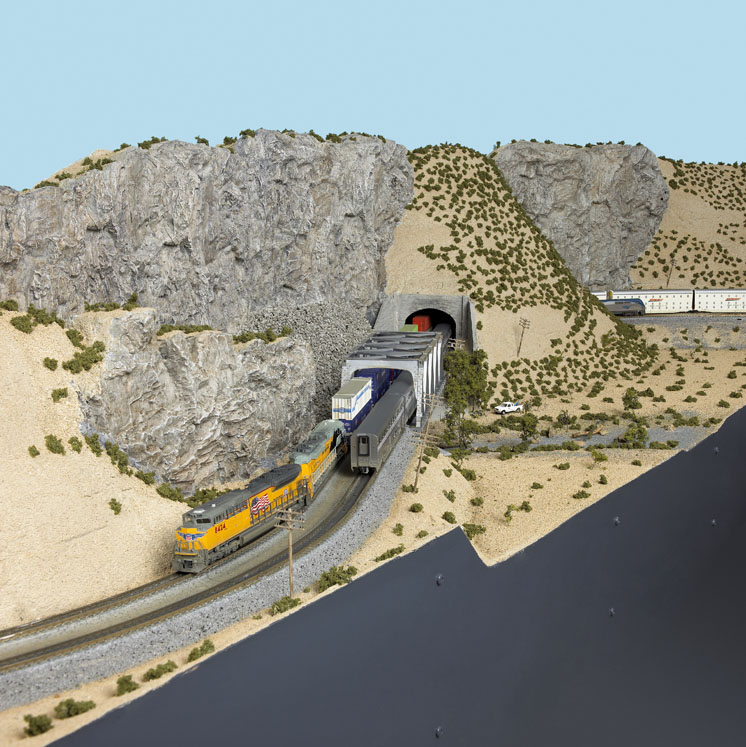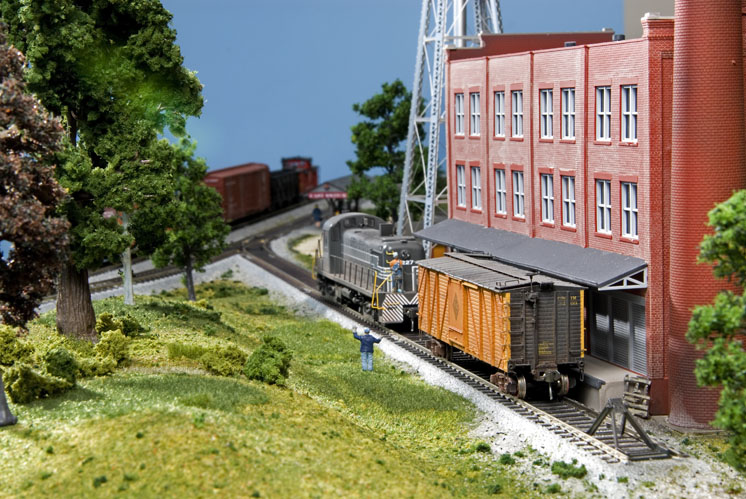Newcomers naturally have many questions about getting started in the model railroading hobby, so we’ve gathered some tips to answer the most common questions we receive year after year.
1. Before you jump right in, you’ll need to think about the physical size, or scale, of the trains that interest you. The most popular sizes are: HO (1:87.1), N scale (1:160), and O (1:48 scale), which is equivalent to the Lionel toy trains. Large scale trains are also popular. They come in a mixture of scales from 1:22.5 to 1:32 but share a common 45mm track gauge. The relationship between the major scales can be seen in the photo above. This choice determines the space that’s required to build a layout.
2. Quality is important when you shop for model trains. Look for good value and check out the entire range of products available. You get what you pay for, so be skeptical of a train set that sells for half the price of a good locomotive. The better quality trains are more expensive, but they deliver superior performance and will last for many years.
3. A little reading provides help from many experts in the hobby. Kalmbach Books publishes an entire library of how-to titles that cover all aspects of model railroading, including track plans, benchwork construction, track laying, wiring, and scenery. One group of books is especially for beginners. Descriptions of all the books can be found on our website at kalmbachbooks.com.
4. Settle on a time and place early on, as it’ll help you choose the trains and related models you really want. Most modelers have a favorite railroad that they enjoy due to a family connection, or they simply like its paint scheme.
5. Follow NMRA standards for best results. The National Model Railroad Association was founded to establish engineering standards so trains from many manufacturers would be interchangeable. The most visible part of these standards is the sheet metal NMRA standards gauge, which is offered in many scales. This gauge is used to check and adjust the dimensions of track, turnouts, wheelsets, and couplers.
While the hobby has never developed a truly standard coupler, the magnetic knuckle couplers made by Kadee (HO and larger scales) and Micro-Trains (N scale and smaller) have become the popular de facto standard couplers. In some cases these couplers must be purchased and added separately. Fortunately, both firms offer a wide range of special coupler sets for easy installation on almost any car or locomotive.
As the Kadee patents recently ran out, many clones have become available that appear on ready-to-run models.
6. Digital Command Control (DCC) is an electronic system that allows simultaneous independent control of multiple trains on electrically continuous tracks. Each locomotive has a receiver called a decoder that responds only to operating commands from a control “cab” that’s electronically linked to it. Thus, many locomotives can operate at once on a single stretch of track on a layout.
Many manufacturers offer DCC systems that are far more flexible and expandable than direct current (DC) power packs and block systems. Many veteran modelers still use DC, but in the long run the cost of both systems is comparable: DCC uses fewer but more expensive components, while the DC system uses many low-cost components that are purchased piecemeal.
7. Starting a layout is when the fun really begins. Most modelers start with a 4 x 8-foot layout, as that’s the common sheet size for plywood. Model Railroader’s February 2011 issue was devoted to layouts of this size (back issues are available). Keep in mind that the ½” thick intermediate grades of plywood will work fine for a layout. Wood screws and glue are recommended as fasteners.
Plywood in grades AC or BC are good choices for our purposes. One side of the sheet is smooth and the other has its surface defects filled with plugs. Both sides are sanded smooth and even.
8. Use generous curves wherever possible. Most train sets come with tight radius curves for use with short cars, small steam locomotives, and four-axle diesels. The larger radius curves don’t force the trains to their mechanical limits, so they’ll run smoother.
Most scale turnouts (switches) branch away from the straight route at an angle instead of the sharp curve found in toy train track. Scale turnouts are specified by a number that indicates this diverging angle: a no. 6 turnout has a 1:6 ratio, and a no. 4 has a sharper 1:4 ratio. See the photo above. Like the wider curves, higher number turnouts work better with long cars and large locomotives.
9. Try some scenery as soon as you have the track laid and wired. Perhaps the best part is any scenery you don’t like can be easily changed or remodeled.
10. Take your time as the layout takes shape – this isn’t a race! Building a model railroad takes time and effort, and doing a quality job will pay off in smoother operation and minimal derailments. As I began my career at Model Railroader nearly 40 years ago, editor Linn Westcott advised me “Never be afraid to try something, because even if it doesn’t work, you’ve still learned from the experience.” Have fun!





